Do you want stretches that make you flexible and less likely to get hurt? Stretching is key for avoiding injuries. It unlocks better movement, lowers injury chances, and boosts activity performance. So, what are the top stretches to prevent injuries?
Here, we’ll look at top stretches experts suggest for lessening injury risk and boosting flexibility. These are great for athletes, anyone loving fitness, or just trying to keep active and safe. Adding these stretches to your daily life can be a game changer.
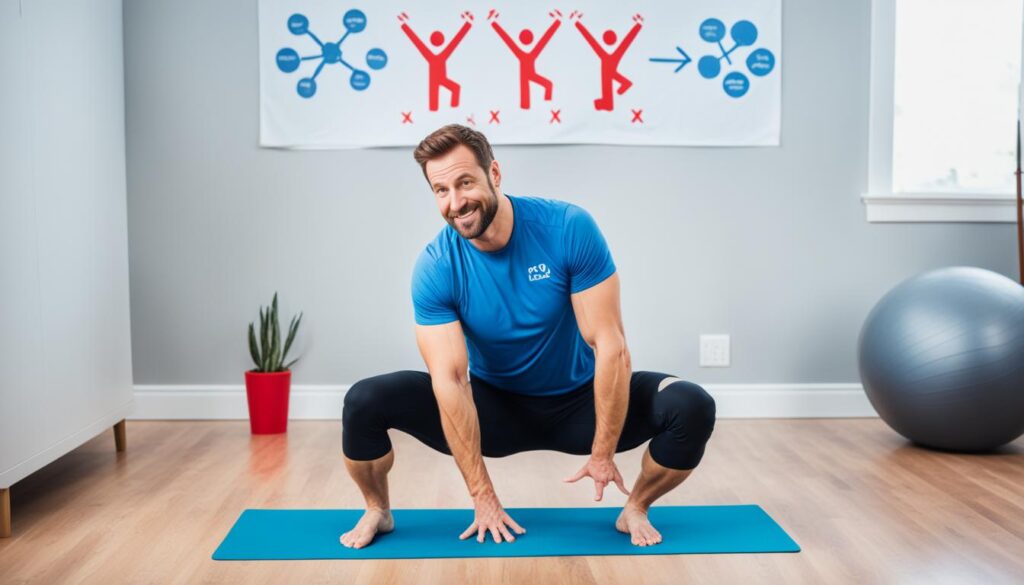
Key Takeaways:
- Stretching often, like two to three times a week, lowers the chance of getting hurt and boosts flexibility.
- Target big muscle groups, don’t bounce, and hold each stretch for about 30 seconds for the best stretching outcomes.
- Adding stretches specific to your sport and gentle movements from tai chi, Pilates, or yoga can help even more with flexibility and lowering fall risks.
- Static stretches can make you more mobile, improve how you position yourself, enhance coordination, power, strength, and reduce injury risks.
- Young athletes should do stretches before and after workouts to stay flexible and avoid injuries.
The Benefits of Stretching
Stretching offers several benefits that can greatly improve your overall physical well-being.
Improved Flexibility and Range of Motion
One key benefit of stretching is it boosts flexibility. This allows for more movement in joints and muscles. Being more flexible can make you better at sports, dance, or day-to-day tasks.
Decreased Injury Risk
Stretching regularly can cut down on injury risks. It makes your muscles and tendons more elastic. This means you’re less likely to have strains, sprains, or other muscle injuries.
Enhanced Performance
Getting more flexible also means you can perform better in sports. Your muscles will work more smoothly and powerfully. This leads to better coordination, power, and strength.
Increased Muscle Blood Flow
When you stretch, blood flows better to your muscles. This brings them the nutrients and oxygen they need. Better blood flow helps muscles work better and stay balanced.
Improved Daily Activities
Stretching makes daily tasks easier. It loosens up tight muscles, so bending and moving are more comfortable. This is especially good for older people or those with mobility challenges.
“Stretching is a simple and effective way to improve flexibility, decrease the risk of injuries, and enhance performance in various physical activities.” – Dr. Sarah Johnson, Sports Medicine Specialist
Mixed Results in Muscle Soreness and Performance
Some research about stretching shows mixed results. But most studies agree it’s good for flexibility and preventing injuries.
| Benefit | Summary |
|---|---|
| Improved Flexibility and Range of Motion | Enhanced performance in physical activities by enabling a greater range of motion in joints and muscles. |
| Decreased Injury Risk | Reduced risk of strains, sprains, and other muscular injuries through improved muscle and tendon elasticity. |
| Enhanced Performance | Improved coordination, power, and strength due to more efficient muscle movement. |
| Increased Muscle Blood Flow | Better circulation leading to improved muscle function and reduced risk of imbalances or stiffness. |
| Improved Daily Activities | Ability to perform everyday tasks with ease due to loosened muscles and improved mobility. |
Adding stretching to your routine has many benefits for your health and well-being. Whether you’re an athlete or just want to move better in daily life, stretching can help you reach your goals.
Stretching Essentials for Injury Prevention
Injury prevention needs stretching in your routine. But, it’s vital to stretch correctly to avoid harm. Here are key points to remember:
- Warm up before stretching: Don’t use stretching as your only warm-up. Begin with light exercises like a quick walk or jog. This warms your muscles, getting them ready for stretching.
- Focus on major muscle groups: It’s crucial to stretch big muscle groups for better flexibility. Aim for the hamstrings, quadriceps, calves, glutes, and hip flexors. Targeting these areas brings the best results.
- Avoid bouncing: Bouncing can hurt you, so avoid it. Go for smooth, held stretches, lasting about 30 seconds. Slow stretching helps muscles extend safely.
- Strive for symmetry: Balanced flexibility prevents muscle issues and injuries. Stretch both sides of your body equally. This promotes good alignment and lowers injury risks.
- Avoid pain: Listen to your body while stretching. If it hurts, you’re pushing too hard. A stretch should feel like a gentle tug, not pain. Pushing into pain is dangerous.
- Incorporate sport-specific stretches: Different activities need different flexibility levels. Add stretches that fit your sport to improve and stay safe. This also betters your performance.
- Regular stretching: Stretching regularly, around 2 to 3 times a week, is best. It keeps you flexible and lowers injury risks. Constant stretching also improves your athletic abilities.
Keep these tips in mind to make your stretching more effective and safe. Stretching not only helps avoid injuries but also ups flexibility and sports performance.
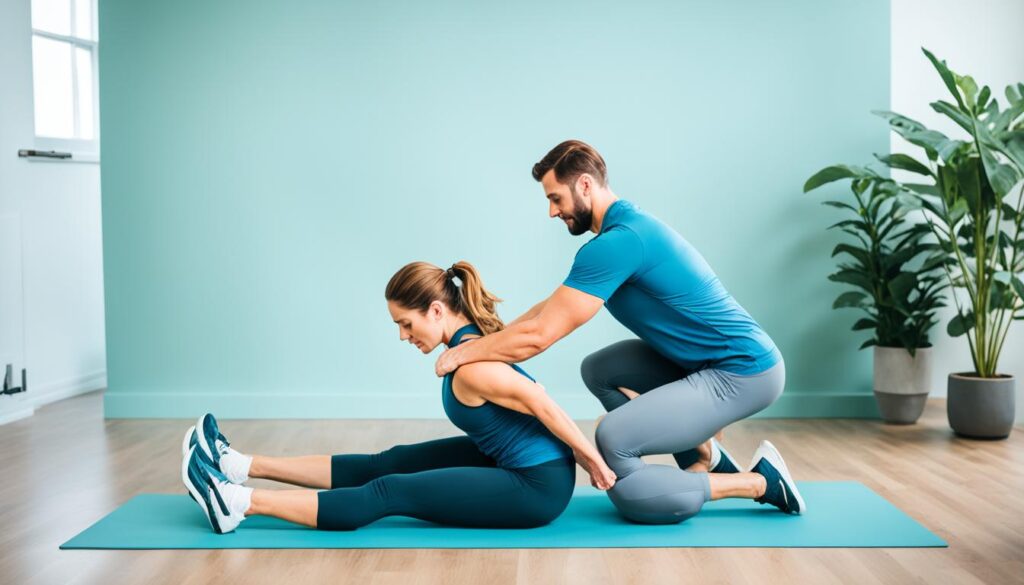
| Benefits of following stretching essentials for injury prevention: |
|---|
| Improved flexibility |
| Reduced risk of injuries |
| Better muscle balance and symmetry |
| Enhanced athletic performance |
| Reduced muscle stiffness |
The Role of Static Stretching in Injury Prevention
Static stretching is key to preventing injuries. It makes you more flexible and helps with positioning. Even though not everyone agrees on its benefits, mixing it with other exercises has been shown to work well.
One big plus of static stretching is more mobility. Holding a stretch long enough makes muscles longer and more flexible. This lets you move better, coordinate well, and get stronger.
Static stretches also lower injury risks. They make you flexible and help avoid muscle injuries. Adding them to your routine, especially with strength training, is a good idea.
But, don’t just focus on static stretching for injury prevention. Your routine should also have strength, balance, and other types of exercises. This mix helps you stay fit and safe.
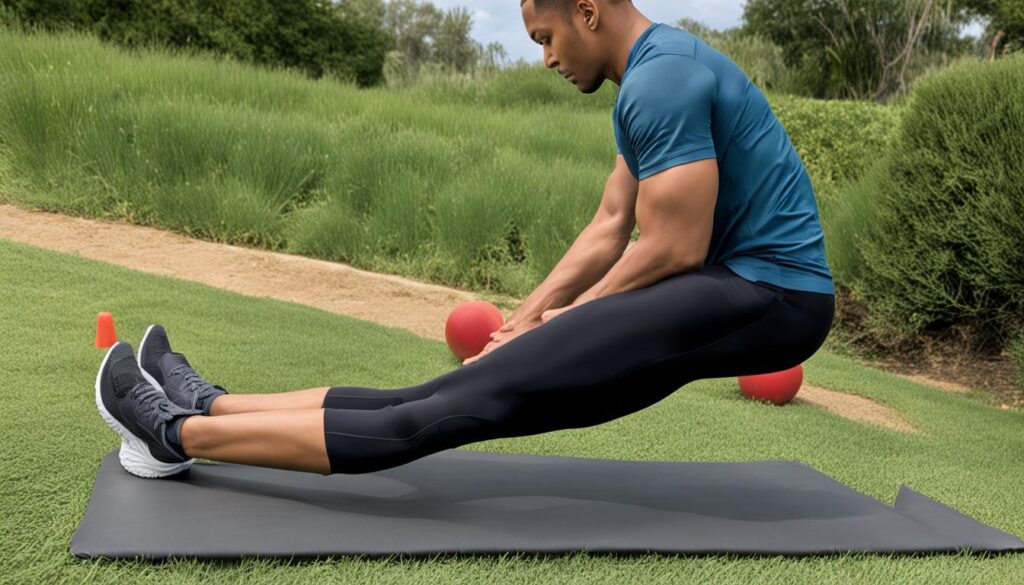
The Benefits of Static Stretching:
- Increases mobility and range of motion
- Improves positioning and body alignment
- Enhances movement, coordination, power, and strength
- Decreases the risk of injuries, such as strains and sprains
Adding static stretching to your routine can lead to better flexibility, fewer injuries, and better physical performance.
| Benefits of Static Stretching | Examples |
|---|---|
| Increased mobility and range of motion | Hamstring stretch, quadriceps stretch |
| Improved positioning | Chest stretch, calf stretch |
| Enhanced movement, coordination, power, and strength | Shoulder stretch, hip flexor stretch |
| Decreased risk of injuries | Groin stretch, lower back stretch |
Effective Stretches for Injury Prevention
To prevent injuries, adding stretches to your routines is key. These stretches focus on certain muscles and boost flexibility. They lower the chance of getting hurt and keep you performing your best. Here are important stretches for staying injury-free:
1. Prone Calf Stretch
The prone calf stretch is easy and targets the calves, which often get tight and injured. Here’s how to do it:
- Start by kneeling, with one foot over the opposite heel.
- Lean forward with your hands, moving towards your feet.
- Gently sway your hips to deepen the stretch.
2. Kneeling Hip Stretch
This stretch is for your hip flexors and boosts hip movement. Important for your lower body. To do the stretch:
- Kneel on one knee with the other foot in front, flat.
- Lift your arms up and gently push your hips forward.
- Feel the stretch at the front of your kneeling leg’s hip.
3. Spiderman with a Twist
The Spiderman with a twist is a cool, moving stretch. It works on your hips, groins, and shoulders. Follow these steps:
- Begin in a push-up pose, hands apart at shoulder width.
- Move one foot outside your hand. Rotate your body to that side.
- Switch sides to stretch both parts of your body.
4. Leg Kicks/Swings
Leg kicks or swings are movements that stretch your hamstrings. They also make your legs more flexible. Here’s how:
- Face a wall for support.
- Swing a leg back and forth, staying in control.
- Then, swing it side to side. Keep movements smooth.
- Do the same with the other leg.
These stretches can make you more flexible, lower injury risks, and improve your performance. Always check with a pro to do them right.
The Importance of Warming Up and Stretching for Young Athletes
Warming up and stretching are key to keep young athletes safe. It prepares the body for exercise. This involves light exercises that make blood flow better to the muscles. Doing this helps athletes perform better and avoid getting hurt. Adding stretches before a workout is good. It makes the body more flexible and ready for what’s coming.
Stretching before working out is very important. It keeps your body flexible and lowers the chance of getting hurt, especially in the knees and ankles. It also makes sure muscles and joints are ready to move. By doing different warm-up stretches that focus on big muscle groups, young athletes can become more flexible. This readies their bodies for workouts.
It’s also important to stretch after working out. Cool-down stretches help the heart rate go down slowly and stop muscles from becoming stiff after working hard. This helps the body recover and stops muscles from hurting the next day. It’s a big part of preventing injuries.
Doing stretches and warm-up exercises regularly stops injuries and makes young athletes more flexible. This helps them do better in sports. It’s important to make these routines a normal part of their workout. This will help them avoid injuries and be more flexible over time.
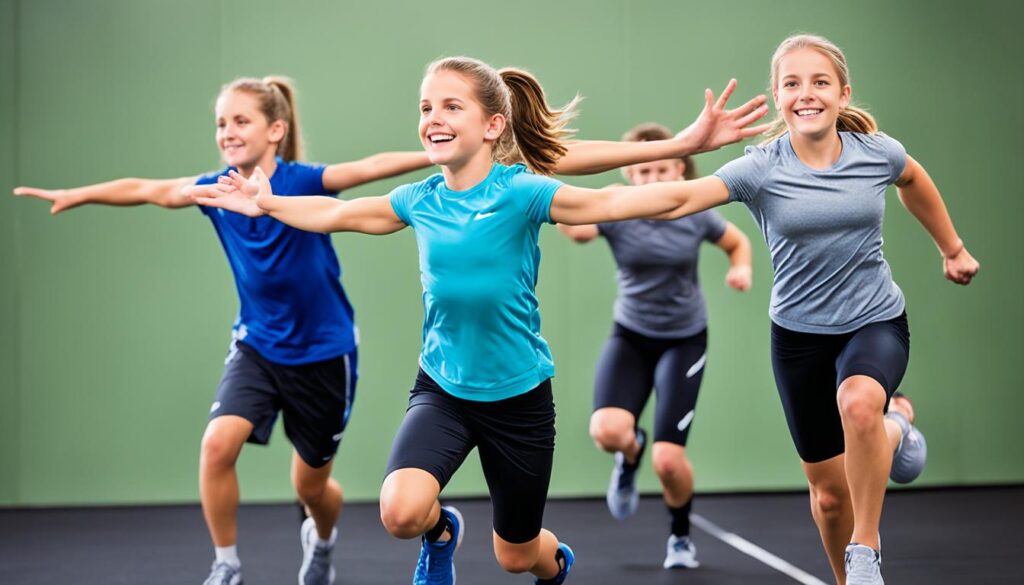
To summarize the importance of warming up and stretching for young athletes:
- Warming up before physical activity increases blood flow to the muscles. This gets the body ready for exercise.
- Stretching before exercise keeps the body flexible. It reduces the risk of injuries, especially in the knee and ankle areas.
- Adding warm-up stretches makes the body more flexible. It gets the body ready for physical demands.
- Cool-down stretches help with recovery. They reduce muscle soreness and stiffness after working out.
- Doing these things regularly improves flexibility and helps athletes perform better.
By focusing on warming up and stretching, coaches and parents can help young athletes stay safe and do their best.
Warm-Up Stretches for Young Athletes
It’s key for young athletes to stretch before sports. This gets muscles ready and helps with flexibility. Let’s look at some top warm-up stretches:
1. Forward Lunge
The forward lunge helps your thighs and hips. Here’s how to do it:
- Stand with feet apart.
- Step forward with your right foot, keeping straight.
- Bend your right knee until your thigh is parallel to the floor.
- Hold for about 20 seconds.
- Then do the same with your other leg.
2. Side Lunge
The side lunge is great for your thighs and hamstrings. Here’s the right way:
- Stand with feet wide apart.
- Lean to the right and bend your knee.
- Keep your left leg straight during this.
- Hold for 20 seconds.
- Switch legs and repeat the steps.
3. Standing Quad Stretch
This stretch focuses on the front of your thigh. To do it:
- Stand up straight.
- Grab a chair for balance.
- Pull your left foot to your back.
- Hold this for 20 seconds.
- Then switch to your other leg.
4. Seat Straddle Lotus
The seat straddle lotus opens your hips and stretches the groin. Follow these steps:
- Sit down with legs in a V.
- Bring your feet together, knees out.
- Lean forward for a stretch.
- Hold it for 20 seconds.
5. Side Seat Straddle
This stretch is for your inner thighs. Here’s how:
- Sit and spread your legs wide.
- Lean to one side towards your foot.
- Hold for 20 seconds for a good stretch.
- Then do the other side.
6. Seat Stretch
The seat stretch is for your hamstrings and back. Here’s what to do:
- Sit with legs in front.
- Try to touch your toes.
- Keep your back straight and hold the stretch.
7. Knees to Chest
This one stretches your back and glutes. To do it:
- Lie down and stretch your legs.
- Pull your knees to your chest.
- Gently pull them closer for the stretch.
- Hold for 20 seconds.
Do each stretch three to six times, holding each for 20 seconds. Adding these stretches to their routine helps young athletes stay flexible, avoid injury, and perform their best.
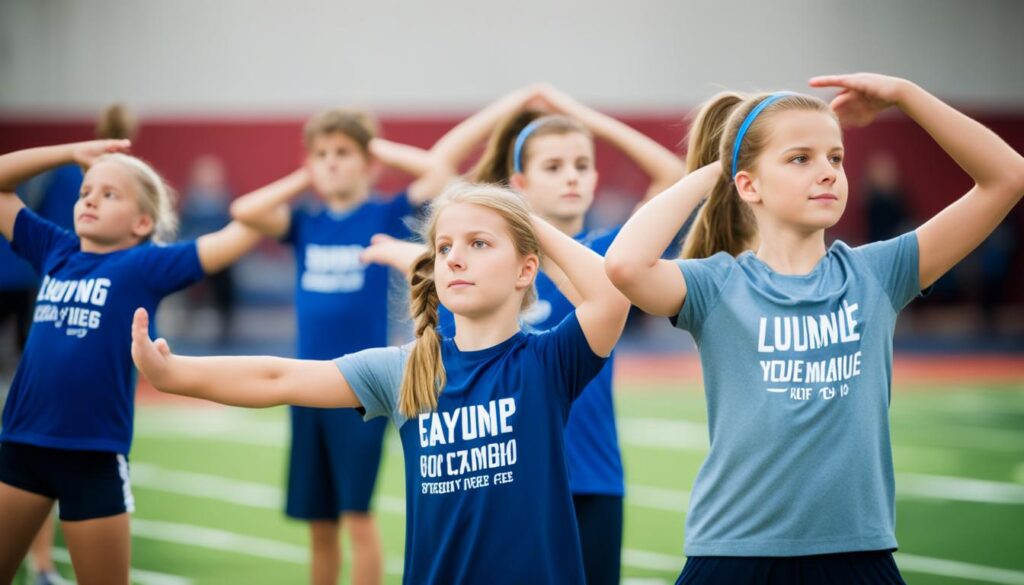
Stretching Frequency for Young Athletes
Young athletes should stretch regularly to boost flexibility and avoid injuries. The American College of Sports Medicine suggests stretching three times a week. This keeps performance and flexibility at their best.
Stretching is key in a warm-up or cool-down routine. It makes the most of the benefits. Warm-up exercises get the muscles ready by boosting blood flow. This makes stretching more effective afterward. Stretching after exercise helps muscles become longer and more flexible. It also supports recovery.
The American College of Sports Medicine has updated its advice. It says to not stretch before working out. A warm-up should have dynamic movements instead. This gets the body ready for exercise. Save stretching for after to get full benefits.
Regular stretching helps young athletes stay flexible and lowers injury risks. Flexibility prevents muscle imbalances and keeps the body aligned. This leads to better performance and fewer strains.
Effective Stretching Frequency and Routine
Here are tips for a good stretching routine:
- Stretch three times a week after warming up or working out.
- Target key muscle areas like the legs and hips.
- Stretch gently for 20 seconds without bouncing.
- Do each stretch two to three times.
- Stop if it hurts. Only a gentle stretch is needed.
By sticking to these tips, young athletes can become more flexible. This lowers their chance of getting hurt and helps them do better in sports.
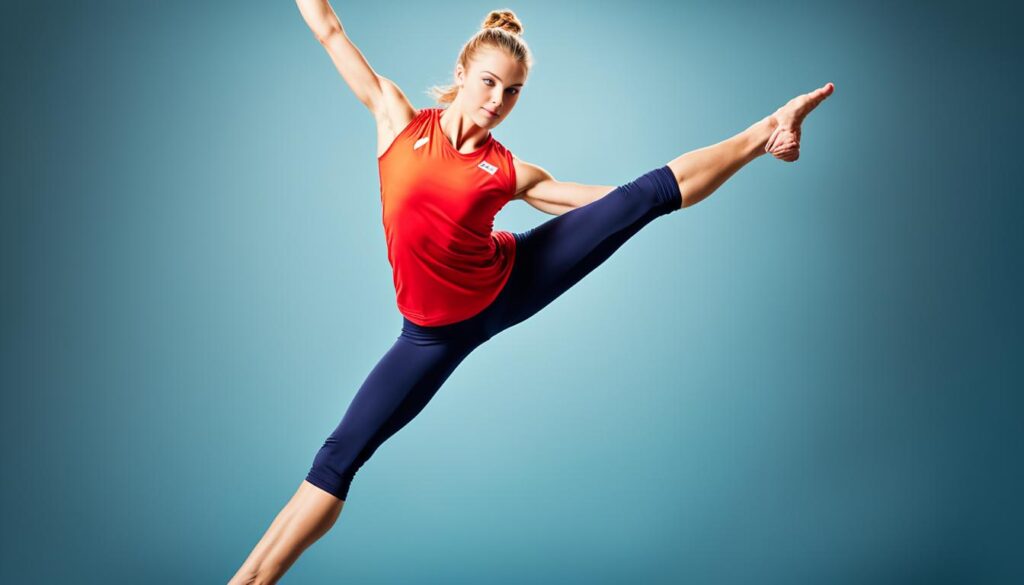
Duration and Repetition of Stretches
The length and repetition of stretches are very important. They help with flexibility and prevent injuries. It’s best to hold each stretch for 20 seconds. This gives muscles time to lengthen and become more flexible.
Avoid bouncing when you stretch. This can cause muscle strains and increase injury risks. Keep the stretch steady and controlled. Stretching shouldn’t hurt; it should feel comfortable.
Repeat each stretch two to three times for every muscle group. This practice boosts flexibility and relaxes the muscles. Adding a regular stretching routine to your fitness plan improves flexibility and lowers injury risks.
Incorporating Stretching into Your Routine
Use this table as a guide for your stretching routine:
| Stretch | Duration | Repetition |
|---|---|---|
| Hamstring Stretch | 20 seconds | 2-3 times |
| Quad Stretch | 20 seconds | 2-3 times |
| Calf Stretch | 20 seconds | 2-3 times |
| Shoulder Stretch | 20 seconds | 2-3 times |
Adjust your stretches to fit your needs. As you get more flexible, you can stretch longer or more often. Aim for two to three stretch sessions each week.
By sticking to these suggestions, you’ll get the most out of stretching. It’ll help prevent injuries and boost your sports performance.
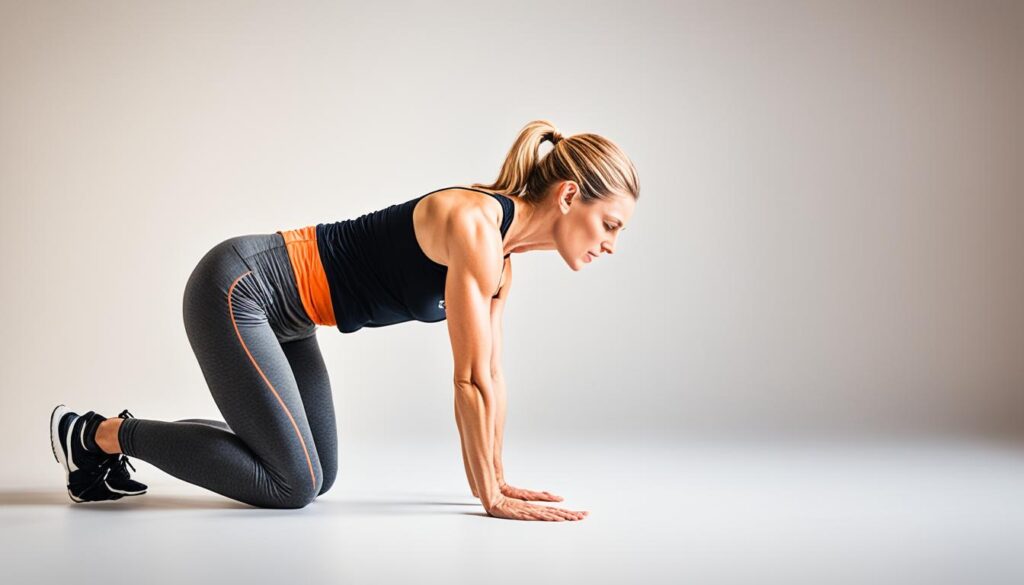
Incorporating Stretching into an Injury Prevention Routine
A consistent stretching routine is key to avoiding injuries and getting more flexible. It should have warm-up stretches before and cool-down stretches after exercise. When young athletes make this a regular part of their routine, they perform better. They also keep their bodies fit for a longer time.
Warm-up stretches get the body ready for exercise by increasing blood flow to the muscles. They make muscles and joints more flexible and less likely to get hurt. Meanwhile, cool-down stretches help muscles relax after working out. They also reduce soreness and help muscles recover faster.
Stretching isn’t just about stopping injuries. It also helps muscles relax. It releases tension which can cause tightness or stiffness. This is great for athletes who do the same moves a lot or have intense workouts. It helps in muscle recovery and eases tension.
A regular stretching routine with warm-up, cool-down, and relaxation stretches boosts injury prevention. It improves flexibility and supports a healthy, active lifestyle for young athletes. They become more flexible and ensure they can keep doing what they love longer.